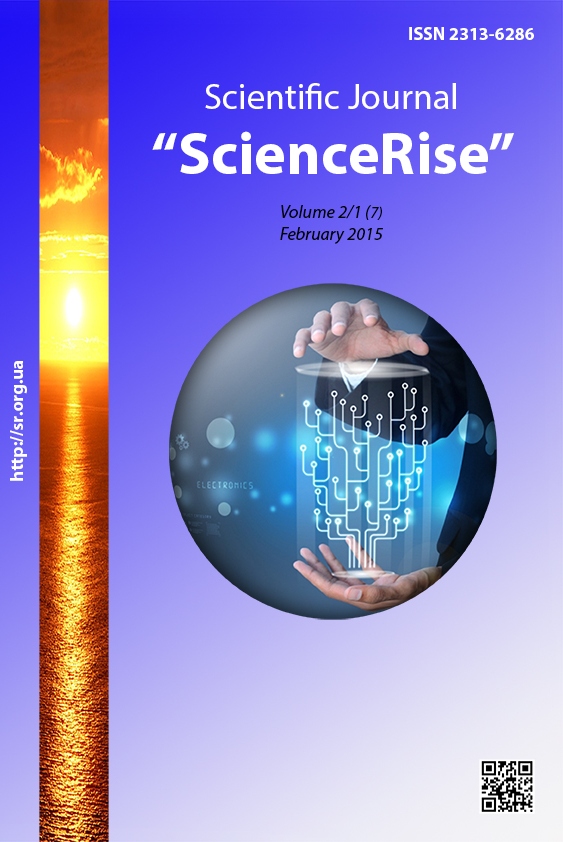The effect of nitrogen oxide on the formation of chromosomal instability in human lymphocytes under the co-mutagenic modification
DOI:
https://doi.org/10.15587/2313-8416.2015.37451Keywords:
nitrogen oxide, co-mutagen, ascorbic acid, blood lymphocytes, chromosome aberration, proliferative potentialAbstract
Aim. Identify the features of formation of chromosomal instability in lymphocytes of nominally healthy individuals under conditions of combined action of nitrogen oxides (NO) and ascorbic acid (AA), depending on their concentration (study in vitro).
Material and methods. Culture of human peripheral blood lymphocytes (PBL) with metaphase analysis of chromosome aberrations. Nitrosated glutathione as the main transport form of NO injected into PBL culture in the concentration range 0,25-0,5-1,0 mmol / ml of blood. As co-mutagen used AA in the concentration range 20,0-40,0-80,0 mg / ml of blood, corresponding therapeutic drug concentrations, as well as 2 and 4 times exceeding its value.
Results. Discovered co-mutagenic effect of AA manifested in increasing the overall frequency of chromosomal aberrations in 1.7 and 1.4 times respectively the concentration of NO. The spectrum induced damage presents a whole by chromatid type aberrations that occur mainly by single-strand DNA breaks and kept stable in a number of cell generations. In all experimental observation points an additional impact of AA (regardless of concentration) strengthened depressing effect of NO in concentration of 1.0 mmol / ml of blood on proliferative potential of cells.
Conclusions. By the action of chemical mutagens NO on blood lymphocytes of nominally healthy persons an additional impact of AA in high concentration (80 mg / ml of blood) complicates chromosome instability of cells, increasing the level chromatid aberrations in 2 times, and inhibits their proliferative potential
References
Maeda, H., Akaike, T. (1998). Oksid azota i kislorodnyie radikalyi pri infektsii, vospalenii i rake [Nitric oxide and oxygen radicals at an infection, inflammation and cancer]. Biochemistry, 63 (7), 1007–1019.
Vink, D. A., Vodovoz, I. G., Kuk, D. A. (1998). Znachenie himicheskih svoystv oksida azota dlya lecheniya onkologicheskih zabolevaniy [Value of chemical properties of nitric oxide for treatment of oncologic diseases]. Biochemistry, 63 (7), 948–957.
Domina, E. A. (2013). Deyaki aspekti genetichnoyi nestabilnostI somatichnih klitin lyudini za kombinovanoyi diyi ionizuyuchoyi radIatsiyi ta oksidu azotu [Some aspects of genetic instability of somatic cells of man are at the combined action of ionizing radiation and nitric oxide]. Herald of Ukrainian Society of Geneticists and Selectionists, 11 (3), 39–45.
Domina, E. A., Pylypchuk, E. P. (2013). Osoblivosti formuvannya radiatsiyno-indukovanih aberatsiy hromosom v klitinah lyudini za umov modifikuyuchogo vplivu himichnih agentive [Features of forming of the radiation-induced aberrations of chromosomes are in the cells of man at the terms of modifying influence of chemical agents]. Problems of Radiation Medicine and Radiobiology, 18 (1), 330–337.
Durnev, A. D., Seredynyn, S. B. (2003). Ko-mutahenez – novoe napravlenie issledovaniy v henotoksikologii [Co-mutagenesis - a new direction of research in genotoksikology]. Bulletin of Experimental Biology and Medicine, 35 (6), 604–612.
Domina, E. A., Pylypchuk, E. P. (2013). Radiatsiyno-indukovani aberatsiyi khromosom v limfotsytakh lyudyny za diyi ko-mutaheniv (doslidzhennya in vitro) [Radiation-induced chromosome aberrations in human lymphocytes by action of co-mutagens (study in vitro)]. Herald of Ukrainian Society of Geneticists and Selectionists, 11 (3), 46–52.
Mikhailenko, V. M., Diomina, E. A., Muzalov, I. I., Gerashchenko, B. I. (2013). Nitric oxide coordinates development of genomic instability in realization of combined effect with ionizing radiation. Experimental Oncology, 35 (1), 58–64.
Cytogenetic Dosimetry: Applications in Preparedness for and Response to Radiation Emergencies (2011). Vienna: IAEA, 232.
Lapach, S. N., Gubenko, A. V., Babich, P. N. (2000). Statisticheskie metodyi v mediko-biologicheskih issledovaniyah s ispolzovaniem Excel [Statistical methods in researches for medicine and biology with the use of Excel]. Kiev, Ukraine: Zdorov’ya, 408.
Grinevich, Yu. A., Chumak, A. A. (Eds.) (2011). Rak schitovidnoy zhelezyi [Cancer of thyroid]. Kiev, Ukraine: Zdorov’ya, 208.
Domina, E. A., Pilinskaya, M. A, Petunin, Yu. I., Klyushin, D. A. (2009). Radiatsionnaya tsitogenetika [Radiation cytogenetics]. Kiev, Ukraine: Zdorov’ya, 367.
Downloads
Published
Issue
Section
License
Copyright (c) 2015 Емілія Анатоліївна Дьоміна, Віктор Михайлович Михайленко, Олена Петрівна Пилипчук

This work is licensed under a Creative Commons Attribution 4.0 International License.
Our journal abides by the Creative Commons CC BY copyright rights and permissions for open access journals.
Authors, who are published in this journal, agree to the following conditions:
1. The authors reserve the right to authorship of the work and pass the first publication right of this work to the journal under the terms of a Creative Commons CC BY, which allows others to freely distribute the published research with the obligatory reference to the authors of the original work and the first publication of the work in this journal.
2. The authors have the right to conclude separate supplement agreements that relate to non-exclusive work distribution in the form in which it has been published by the journal (for example, to upload the work to the online storage of the journal or publish it as part of a monograph), provided that the reference to the first publication of the work in this journal is included.

